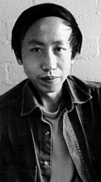[
homepage
|
subscribe
|
feedback
|
guestbook
|
contents
|
post
]
architecture
¥
film
¥
food
¥
music
¥
nitelife
¥
performing arts
¥
style
Huang Yong Ping's innovation involves a confrontation with history, a
reintegration, recapturing, of something which has been lost.

From time to time, artists achieve creative brilliance by merely highlighting
an existing situation, leading people to recognize an intriguing presence or
hitherto unnoticed gap in their surrounding culture. This is precisely what
was so strong about Chinese artist Huang Yong Ping's contribution to the
Ripple Across the Water exhibition held in Aoyama this past fall.
To be sure, the entire Ripple Across the Water exhibition is worthy of
an award. Organized by the Watari-Um museum and guest-curated by Jan Hoet of
the Museum Van Hedendaagse Kunst in Ghent, Belgium, the show brought together
46 artists from across the world, some famous, some emerging, to construct
site-specific sculptural installations all over Aoyama during the month of
September. It was a remarkable undertaking, the more surprising because so
much of the work was excellent. But beyond this, the community which hosted
it--lending its streets, yards and places of business to "Art" for a month--was
unexpectedly enthusiastic and involved. One-hundred-and-eighty people
volunteered to assist the project, and an estimated 20,000 viewed the works.
So what was so special about Huang's work in this context? In formal terms,
it was a great Buddha fashioned out of strips of bamboo and festooned with tiny
chimes, situated within the upper reaches of a stark, concrete water tower
which serves a public housing development. Transforming the entire drab
development with an unexpected fragility, Huang's Buddha reminded us of the
life that goes on behind the walls of the city, and of the tenderness that
might still be found behind even the gravest urban mask. The residents of the
housing complex were enthralled and considered the work a great gift,
expressing hope that it would be allowed to remain permanently. In
art-historical terms, Huang achieved a critical detournement of a key pan-Asian
cultural icon, stressing the shared roots of his native China and the Japanese
society which hosted him, while reminding us that the links which bind the
image to our daily life--above all the compassionate ideal--have all but
dissolved.
In this case, innovation involves a confrontation with history, a
reintegration, recapturing, of something which has been lost. For this we
thank Huang.
architecture
¥
film
¥
food
¥
music
¥
nitelife
¥
performing arts
¥
style
[
homepage
|
subscribe
|
feedback
|
guestbook
|
contents
|
post
]
Copyright © Tokyo Journal
